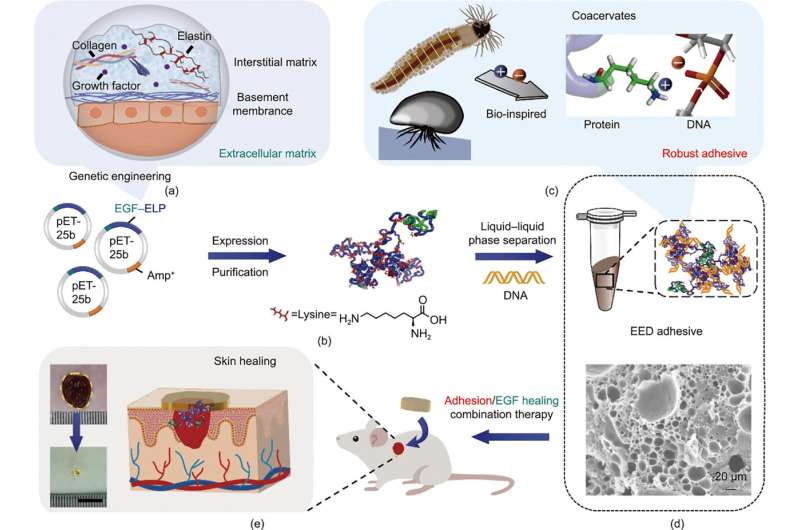This article has been reviewed according to Science X's editorial process and policies. Editors have highlighted the following attributes while ensuring the content's credibility:
fact-checked
proofread
New frontier in biomedical engineering: Protein coacervates engineered into adhesive for unprecedented skin repair speed

A team of researchers from China has made a significant breakthrough in biomedical engineering by developing a novel adhesive that promises to revolutionize wound management and tissue repair. The research, published in Engineering, unveils a biocomposite adhesive that exhibits robust adhesion and real-time skin healing properties.
Adhesives have long been recognized as a valuable tool in biomedical engineering. However, current adhesive systems face challenges in achieving strong and durable adhesion, limiting their effectiveness in wound healing. Additionally, conventional chemical adhesives lack the ability to adapt to dynamic changes in the wound environment, hindering tissue regeneration.
In response to these challenges, the Chinese research team engineered an extracellular matrix (ECM)-derived biocomposite adhesive that overcomes the limitations of existing adhesives. By harnessing liquid–liquid phase separation and leveraging supramolecular interactions between chimeric protein and natural DNA, the researchers achieved a reinforced adhesion performance in the biocomposite adhesive.
The newly developed adhesive demonstrates exceptional adhesion and sealing behaviors, surpassing its reported counterparts with a sheared adhesion strength of approximately 18 MPa. The engineered bioderived components not only enhance adhesion but also promote cell proliferation and migration, enabling real-time in situ skin regeneration.
The research team's innovative approach involved actively introducing biological components and employing a rational design process to create the adhesive. Liquid–liquid phase separation, driven by electrostatic complexation between a chimeric epidermal growth factor (EGF), elastin-like protein, and natural DNA, facilitated the assembly of the adhesive. The resulting adhesive demonstrated exceptional adhesion on various substrates, including glass, ceramic, aluminum, steel, and soft tissues such as liver, muscle, and porcine skin.
The adhesive's remarkable adhesion strength of (18.9 ± 0.9) MPa on steel substrates and adhesion energy of (40.0 ± 5.3) J·m−2 on pigskin surpassed many reported adhesives. Furthermore, the adhesive exhibited hemostatic behavior, promoted cell proliferation and migration, remodeled the ECM, and accelerated in situ skin regeneration.
The potential applications of this novel adhesive extend beyond wound healing and tissue repair. The research team believes that the unique fabrication strategy holds great promise in the design of next-generation functionalized bioadhesives for broader applications, including bioelectronics and wearable health systems.
Nan Zhang, editor of the subject of chemical, metallurgical, and materials engineering of Engineering, stated that this work opens up novel avenues for functionalized bioadhesive engineering and biomedical translations. The adhesive, which has been engineered from ECM components, demonstrates biocompatibility and extraordinary biological functions, making it a promising candidate for biomedical adhesion and healing applications.
More information: Ming Li et al, Engineering Protein Coacervates into a Robust Adhesive for Real-Time Skin Healing, Engineering (2023). DOI: 10.1016/j.eng.2023.07.013





















